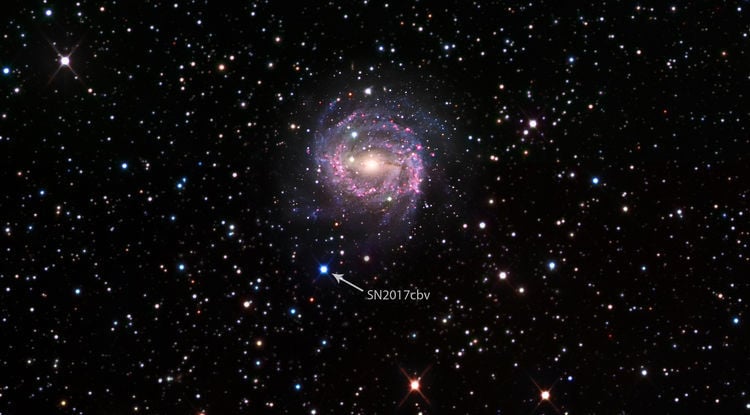Earlier this year, astronomer David Sand and his team were searching about 500 galaxies a night using the PROMPT telescope in Chile to find supernova — an exploding star.
Just before heading to bed on the night of March 10, Sand, an assistant professor of astronomy who joined the University of Arizona faculty last month, was alerted by the automated telescopes surveying the sky that a new bright light had just appeared in a galaxy 55 million light years from Earth.
The telescopes had just captured the earliest moments of a Type Ia supernova explosion, one of the closest discovered in recent years. But this supernova was different. There was a small anomaly in the data coming in.
To investigate it in unprecedented detail, Sand set into motion the Las Cumbres Observatory global network of 18 telescopes, which allowed him to continue to watch the supernova every five hours.
Sand and his team sought to further investigate the physics of this Type Ia supernova, designated SN 2017cbv.
Teasing out the differences in a Type Ia supernova and what triggers it will help astronomers make more accurate measurements of distances in the universe, improve the study of dark matter and dark energy and the expansion rate of the universe.
What are supernovas?
A supernova is the death of a star, seen as a bright explosion deep in the sky that appears suddenly, outshining galaxies for days before fading away.
Type Ia supernovas are a specific subset of supernova that are created by white dwarfs, the dense corpse of a dead star, interacting with a companion star in a violent explosion.
Astronomers think most stars — but not the sun — have what are called companion stars, meaning more than one star per stellar system.
There are a few ideas about what triggers the violent explosion of a Type Ia supernova, but Sand’s observation is the latest in a growing body of evidence for one idea in particular for this specific supernova.
The theory is that a white dwarf strips away material from its companion, slowly accumulating the stolen mass around itself. Once the star accumulates a certain amount of material, called the Chandrasekhar limit, it explodes as a Type Ia supernova, then the explosion hits the companion star.
This is probably what Sand saw that night — the big explosion followed by a “shock” to the companion star that appeared as an anomaly in the data.
The mysterious bump
Astronomers collect data on stellar objects in the form of light curves, a graph in a rough bell shape that reveals certain characteristics of the star. The light curve for this Type Ia supernova, however, had an extra little bump in its bell-shaped curve.
“There have been hints of this bump before,” Sand said, but there was not enough evidence to determine whether it was nothing more than data error, he said. “When you have one, you think, ‘I probably screwed something up.’”
But the network of telescopes got more corroborating data, making him more certain this bump was more than a mistake.
“It’s so overwhelming, you can’t deny it,” he said. “The stars aligned and we got really good data.”
Sand’s observation backs up the idea that the white dwarf exploded as a Type Ia supernova (the big, bright explosion he saw), which then “shocked the companion star,” (the little bump).
Universal tools
Sand and other astronomers are interested in young supernovas because they have the most to teach.
“In the very earliest hours (of the explosion), there are hints of what was there before,” Sand said, which might provide clues to the cause of the explosion.
“Type Ia are pretty good standard candles,” Sand said, meaning they are all roughly uniform in brightness when they explode, so they can be used to determine the distance of the galaxy they are in.
“They’re kind of like 60-watt light bulbs at the end of a football field. If you measure the light from it, you can figure out with a calculator how far away it is.”
The problem is, “Type Ia are not all exactly 60 watts.” The brightness can range a bit, but astronomers don’t know why.
But if they can figure out what causes the slight variations in brightness, it can make distance measurements in the universe more accurate and, ultimately, lead to a better understanding of dark matter and energy and an accurate measurement of the expansion rate of the universe.





